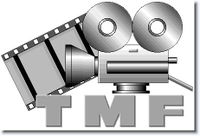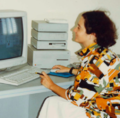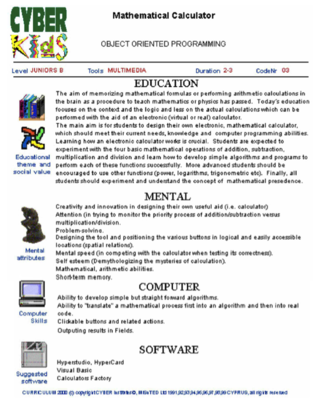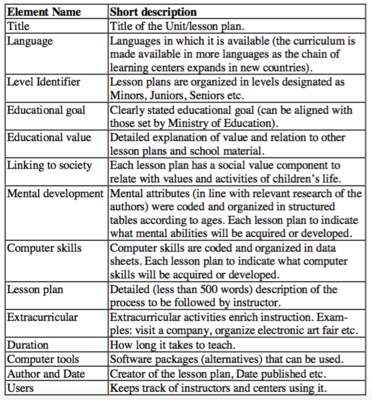The Multimedia Factory
|
CYBER KIDS was a nation-wide social entrepreneurial experiment launched in 1992 in Cyprus by Yiannis Laouris, George Vakanas and Maria Symeonides. The Research and Development of its award winning curriculum was done by the Cyprus Neuroscience and Technology Institute. Within the first five years (1992-1997) 26 computer- learning centers were launched with average of 50-150 students enrolled every year in each location. By 1999, the number of children who benefited from the Cyber Kids curriculum in the 36 Branches exceeded 15,000, which is approximately equal to 20% of the country’s youth population (ages 6-15). CYBER KIDS has also contributed against brain drain by employing a total of 186 young scientists between 1991-1999. More importantly, MISnTED Ltd., the owner company had a policy of employing teachers from the public educational system as part-timers as a means of contributing to a large-scale reform from within the system.
The Founders
The "profitable dream" concept
CYBER KIDS was based on a concept coined by its creators then called the "profitable dream":
- They envisioned that introducing advanced computer technology in the lives of a critical number of young children using an educationally relevant and socially responsible, peace-enhancing curriculum would allow them to promote creativity, innovation, imagination, and problem solving abilities, thus “transcending” the country’s educational and political life and move the new generation a decade ahead.
The project was founded on a well-defined vision statement:
- ... to re-define the tools, methods and purpose of education, in light of relevant social change.
Company evolution and death
CYBER KIDS was an internationally registered trademark of the mother company, MISnTED: Management Information Systems & Technology Development. The three founding members, Yiannis Laouris, George Vakanas and [[Maria Symeonides] donated 30% of their total shares to the Cyprus Neuroscience and Technology Institute in order to fund its socially responsible research operations. In addition, MISnTED: Management Information Systems & Technology Development provided yearly grants to Cyprus Neuroscience and Technology Institute for research. The project was originally funded by the partners' and by a CY £44,000 government loan. All key people were invited to join as partners: Dinos Georgiades, Evros Alexandrou, Harry Anastasiou, and all employees were given shares totalling to £250,000 of value. In 1996, the Cyprus Development Bank became a partner with 10% in the Cyprus (mother) company and 30% in the Greek subsidiary, investing £100,000 and £300,000 respectively. It was under the leadership of the Cyprus Development Bank, that in 2000 CYBER KIDS merged with 11 other companies to form a public, high-tech company known as CYBER GROUP. Unfortunately, the crash of the stock markets in combination with a number of unconstitutional laws passed repetitively by the Cyprus Parliament allegedly to "protect" the rights of investors, forced CYBER KIDS to bankruptcy along with more than 100 other entrepreneurial companies.
The Multimedia Factory in the Media
CYBER KIDS enjoyed substantial visibility from many media.
The Innovation
The award-winning curriculum of CYBER KIDS was characterised by a number of innovations:
- Each lesson has 4 phases:
- Stimulation leading to role reversal Discovery
- Discussion about tools necessary (Identify tools)
- Learn the tool and use it to complete the project
- Deliver the product
- The focus is on projects and technology is never mentioned
- Each lesson is structured as a KnowledgePacket, combining goals in multiple dimensions
A KnowledgePacket® is composed of:
- The actual know-how and data to transmit to receiver/learner
- The Method of Delivery/Transmission and/or Lesson Plan
- The Tools to use in the process
- The Mental Development that will take place during the learning process
- Real-life applications of the specific knowledge
- Social value and importance of the specific knowledge"
- Author of the KnowledgePacket 8. Owner of the KnowledgePacket
CYBER KIDS Awards
- Qualidat 1996, Geneva, Switzerland
- The Elected of the Year '96, Jerusalem, Israel
- CYBER KIDS Award for Creativity by the Employers and Industrialists Federation (1998)
- INPEX Pittsburgh 95 Silver Award for CYBER KIDS Innovative Curriculum
External Links
http://www.cyber-kids.net/cyberkidsnet/index.php?title=Main_Page
Related Publications
- Laouris, Yiannis (2014). Teams Construct Knowledge During Project-Driven Social Interactions: A Facet of the CYBER Kids Method. Benjamin Press, Tokyo, New York.
- O’Neill, Brian and Laouris, Yiannis (2013). Teaching Internet Safety, Promoting Digital Literacy; The Dual Role of Education and Schools. In: Promoting a Safer Internet for Children. European Policy Debates and Challenges, Brian O’Neill, Elisabeth Staksrud and Sharon McLaughlin (Eds.), Chapter 10, Nordicom 191-207.
- Mascheroni, Giovanna, Murru, Maria Francesca, Aristodemou, Elena and * Laouris, Yiannis (2013). Parents: Mediation, Self-regulation and Co-regulation. In: Promoting a Safer Internet for Children. European Policy Debates and Challenges, Brian O’Neill, Elisabeth Staksrud and Sharon McLaughlin (Eds.), Chapter 11, Nordicom 209-223.
- Kirwil, L., and Laouris, Y. (2012). Experimenting with the Self- presentation Online: A Risky Opportunity, In: Livingstone, S., Haddon, L., and Goerzig, A. (Eds.), Children, risk and safety online: Research and policy challenges in comparative perspective, Bristol: The Policy Press.
- Laouris, Y. (2011). Are our children losing their identities in the emerging networked world?, Part VI, Chapter 16. Healy J. (Ed.), Endangered Minds. Greek edition. Create Space, USA (In press).
- Haddad, C. and Laouris, Y. (2011). The ability of children with mild learning disabilities to encode emotions through facial expressions. In Towards Autonomous, adaptive and context-aware multimodal interfaces: Theoretical and Practical Issues. A. Esposito, Esposito, A.M., Martone, R., Müller, V.C., Scarpetta, G (Eds.): COST 2102 Int. Training School 2010, Lecture Notes In Artificial Intelligence Springer-Verlag, Berlin, Heidelberg 6456, 387-402.
- Laouris, Y., Makris, P., Papadopoulos, T. (2011). Validation of MAPS in 16 schools: Computer-based battery of 8 mental attributes tests (in preparation; draft available).
- Laouris, Y. & Eteokleous (2005). We need an educationally relevant definition of mobile learning. (Originally presented in. Proc. 4th World Conference on Mobile Learning, mLearn 2005, Oct 25 – 28, Cape Town, South Africa) On line: www.mlearn.org.za/CD/papers/Laouris%20&%20Eteokleous.pdf
- Laouris, Y. (2011). Are our children losing their identities in the emerging networked world?, Part VI, Chapter 16. Healy J. (Ed.), Endangered Minds. Greek edition. Create Space, USA.
- Laouris, Y. (2011). Change society bottom up: The Cyberkids experiment, Part IV, Chapter 10 & The Future is mobile, Part VI, Chapter 11. In J. Healy (Ed.), Failure to Connect, Greek edition. Create Space, USA.
- Laouris, Y. & Anastasiou, H. (2005). The introduction of IT in the lives of children as a service to global peace: Experiences from a nation-wide experiment 15 years after. Proc. 4th World Conference on Mobile Learning, mLearn 2005, Oct 25 – 28, Cape Town, South Africa. On line: www.mlearn.org.za/CD/papers/Laouris%20&%20Anastasiou.pdf.
- Eteokleous, N., & Laouris, Y. (2005). Are we moving too fast towards integrating mobile devices into educational practices? Proc. Seeing, Understanding, Learning in the Mobile Age, Budapest, April 28–30, 2005, 197-205. Abstract at: http://www.fil.hu/mobil/2005/Laouris-Eteokleous.pdf. Full paper: http://www.cnti.org.cy/cnti_research/Publications/ConferenceFullPapers/Cyprus_Budapest150305.pdf
- Laouris, Y., & Eteokleous, N. (2005). Experiences from the application of knowledge packets as means for educationally, mentally, and socially balanced instruction. Recent Research Developments in Learning Technologies. 485-489. On line: http://www.formatex.org/micte2005/195.pdf
- Laouris, Y. (2005). Educationally relevant meta-data in learning objects: Necessary condition for re-usability. In: O. I. Hillestad & A. Bopardikar (Eds.), Proceedings Cost276, May 26-28, 2005, pp 61-66, Trondheim, Norway.
- Vakanas, G., Laouris, Y., Symeonidou, M., Loizou, E., Stylianou, S., Kouppe, P., and Georgiades, D. (1994). Mythology as a rich and meaningful context for integrated learning of literacy, numeracy and scientific inference: New possibilities. In J. Wright & D. Benzie (Eds.), Exploring a New Partnership: Children, Teachers and Technology, Proceedings of the IFIP TC3/WG3. 5 International Working Conference on Exploring a New Partnership: Children, Teachers and Technology, Philadelphia, PA, USA, 26 June - 1 July, 1994. IFIP Transactions A-58 Elsevier 1994, pp. 173-179.











